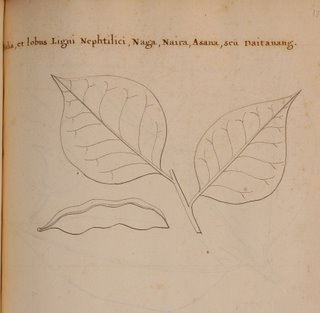josef george kamel, s.j. drawing of narra

Narra [Pterocarpus indicus Wild] Syn: nara, naga, dungos, asana. This is a large tree growing to 25 m. If left to grow apart from other trees it develops a wide crown, but in dense tropical forests it grows straight and tall and has a crown at the very top. The trunk is supported by buttress roots called dalig in Tagalog. The tree is indigenous to Southeast Asia. It sheds its leaves after the cold season and quickly shoots young leaves better adapted to the coming summer months. Around March or April, narra blooms profusely but for a short time. After one day its small bright yellow flowers fall to the ground. After that seed pods develop.
Narra also known as Philippine mahogany is treasured for its fine-grained reddish brown or blond hardwood (narrang-pula and narrang-puti or narra blanca, respectively). Tindalo or balayong (Afzelia rhomboides Vidal) is often mistaken for red narra, which it resembles. Tindalo as the scientific name points out belongs to an altogether different genus from narra. The confusion is further exacerbated because tindalo is also known as mahogany. The term “mahogany” does not designate a particular tree; mahogany rather is a trade name for lumber that may come from various hardwood trees like narra or balayong or yakal (Shorea astylosa) or the South American mahogany (Swietenia macrophylla) introduced as landscaping material by the Americans early in the 20th century. Mahogany’s characteristics are that it close-grained, tropical in origin and has a reddish brown hue.
Polished to a shine narra is used for furniture, floor and wall boards. The lumber tends to retain its natural oil for years and hence is easy to maintain. It is hardly used as structural members of a house that being answered by harder woods like molave, dungon and the like.
The narra is the Philippine national tree.

0 Comments:
Post a Comment
<< Home